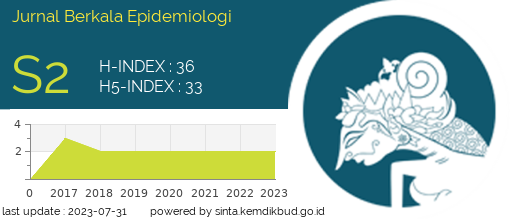Relationship Between Method and Duration of Contraception Usage to Subjective Health Complaints
Downloads
Subjective health complaints are symptoms and unpleasant feelings felt by respondents. Health complaints are the biggest cause of acceptors to stop using contraception. The purpose of this study was to look at the relationship between subjective health complaints on family planning acceptors based on contraceptive methods and length of use. This research was an observational analytic study using a cross-sectional design. The study population was contraceptive acceptors living in 6th Sub Village, Kalitengah Sub-District, Sidoarjo District. The sampling technique used in this study is the simple random sampling technique. The independent variables of the study are the type of contraception and the length of use. The statistical test used is the Chi-square test to determine the relationship between variables. The results showed that more respondents were more than 35 years old (62.5%), had senior high school education (59.7%), and were housewives (70.8%). Statistical test with chi-square shows that there is a relationship between contraceptive methods (p = 0.0098) and length of use of contraception (p = 0.012) with subjective health complaints. The hormonal contraceptive method can increase the risk of 4.05 times to experience subjective health complaints compared with respondents who use non-hormonal contraception. Respondents with a duration of contraception ≤ 5 years can increase the risk of 7.82 times to experience subjective health complaints compared with respondents who use contraception for more than 5 years. It was concluded that the method of contraception and the duration of use of contraception was associated with subjective health complaints. It is recommended that midwives educate respondents using hormonal contraception to switch to using non-hormonal contraception when experiencing complaints.
Anggia, RJ. 2013. Hubungan Jenis dan lama pemakaian kontrasepsi hormonal dengan gangguan menstruasi di BPS Wolita M. J. Sawong. kota Surabaya. Skripsi. Surabaya: Universitas Airlangga.
Badan Penelitian dan Pengembangan Kementerian Kesehatan RI. 2013. Riset Kesehatan Dasar 2013. Jakarta: Kementerian Kesehatan RI.
Badan Penelitian dan Pengembangan Kementerian Kesehatan RI. 2012. Riset Kesehatan Dasar 2012. Jakarta: Kementerian Kesehatan RI.
Badan Kependudukan dan Keluarga Berencana Nasional. 2013. Survei Demografi dan Kesehatan Indonesia 2012. Jakarta: BKKBN.
Badan Kependudukan dan Keluarga Berencana Nasional. 2014. Peserta KB Aktif Wanita. [online] Avaible: http://aplikasi.bkkbn.go.id [diakses 18 Oktober 2015]
Budi dan Riyanto A. 2013. Kapita Selekta Kuisioner. Jakarta: Salemba Medika.
Everett, S. 2007. Buku saku kontrasepsi dan kesehatan seksual reproduktif. 2nd ed. Jakarta: EGC.
Fakhidah, L.N. 2014. Hubungan Lama Penggunaan Kontrasepsi Suntik 3 Bulan dengan Kejadian Keputihan Di Bidan Praktek Swasta Fitri Handayani Cemani Sukoharjo. Maternal. Vol. 10. Edisi April 2014.
Hartanto, H. 2013. Keluarga Berencana dan Kontrasepsi. Jakarta: Sinar Harapan.
Irianto, Koes. 2014. Pelayanan Keluarga Berencana Dua Anak Cukup. Bandung: Alfabeta.
Jones, G.W. 2013. The Population of Southeast Asia. Asia Research Institute. Working Paper No. 196.
Kusuma, N. 2015. Risiko keluhan Kesehatan Subyektif pada Akseptor KB Berdasarkan Metode, Lama Pemakaian dan Riwayat Kontrasepsi Sebelumnya. Skripsi. Surabaya: Universitas Airlangga.
Kothari dan Bhisma. 2006. Desain dan Ukuran Sampel untuk Penelitian Kuantitatif dan Kualitatif di Bidang Kesehatan. Yogyakarta: Gadjah Mada University Press.
Manuaba, IBG. 2010. Ilmu Kebidanan Penyakit Kandungan dan KB untuk Pendidikan Bidan. Jakarta: EGC.
Mato, R dan Rasyid, H. 2014. Faktor-faktor yang Memengaruhi Efek Samping pada Pemakaian Alat Kontrasepsi Suntik Depo Provera di Puskesmas Sudiang Makassar. Vol. 5 No. 2.
Notoatmodjo, S. 2007. Pengantar Pendidikan Kesehatan dan Ilmu Perilaku Kesehatan. Yogyakarta: Andi off set
Population Reference Bureau. 2014. 2014 world population data sheet. [online] Avaible:http://www.prb.org/publications/datasheets/2014/2014-world-population-data-sheet.aspx [diakses 18 Oktober 2015]
Syahlani, A., Redjeki, S.S.D., dan Rini. 2013. Hubungan Penggunaan Kontrasepsi Hormonal dan Pengetahuan Ibu tentang Perawatan Organ Reproduksi Dengan Kejadian Keputihan di Wilayah Kerja Puskesmas Pekauman Banjarmasin. Dinamika Sehat. Vol. 12. No. 12.
Sety, L.M, 2011. Jenis Pemakaian Kontrasepsi Hormonal san Gangguan Menstruasi di Wilayah Kerja Puskesmas. Jurnal Kesehatan. Vol. V. no. 1. Hal. 60–66.
Setyaningrum, A. 2008. Hubungan Lama Pemakaian Depo Medroksi Progesterone Asetat dengan Gangguan Menstruasi di Perumahan Petragriya Indah Purwodadi Tahun 2008. Berita Ilmu Keperawatan. Vol. 1. No. 4 hal. 151–156.
Siswosudarmo, Anwar, M., dan Emilia, Ova. 2007. Teknologi Kontrasepsi. Yogyakarta: Gadjah Mada University Press.
Suratun, S. Heryani, dan Manurung, S. 2008. Pelayanan Keluarga Berencana dan Pelayanan Kontrasepsi. Jakarta: Trans Ifo Media.
Suryati. 2013. Pengaruh Alat Kontrasepsi Suntik terhadap Siklus Menstruasi pada Pasangan Usia Subur (PUS) di Bidan Praktek Swasta (BPS) Heramuliati Kecamatan Pdang Tiji Kabupaten Pidie tahun 2013. Skripsi. Banda Aceh: STIK U'budiyah.
Sutriyani, Dyah, 2013. Perbedaan Lama Pemakaian Alat Kontrasepsi dalam Rahim (AKDR) menurut Keluham Akseptor di Kelurahan Sampangan Kecamatan Gajah mungkur Kota Semarang Tahun 2013. Skripsi. Semarang: Universitas Diponegoro.
Sitompu, Selli Dosriani. 2013. Hubungan Pengetahuan Akseptor Keluarga Berencana. Dengan Penggunaan Alat Kontrasepsi di Puskesmas Helvitia Medan. Skripsi. Medan: Universitas Darma Agung.
Varney, H. 2007. Buku Ajar Asuhan Kebidanan Edisi 4. Jakarta: EGC.
Wiknjosastro, Hanifa. 2007. Ilmu Kebidanan. Jakarta: Yayasan Bina Pustaka Sarwono Prawirohardjo.
Zannah, I.R, Maryati, I., dan Widiasih, R. 2011. Gambaran Keluhan-keluhan akibat Penggunaan Alat Kontrasepsi IUD di Wilayah Kerja Puskesmas Sukajadi Kabupaten Bandung. Jurnal Ilmiah Universitas Padjajaran.
- Every manuscript submitted to must observe the policy and terms set by the Jurnal Berkala Epidemiologi
- Publication rights to manuscript content published by the Jurnal Berkala Epidemiologi is owned by the journal with the consent and approval of the author(s) concerned. (download copyright agreement)
- Complete texts of electronically published manuscripts can be accessed free of charge if used for educational and research purposes according to copyright regulations.

JBE by Universitas Airlangga is licensed under a Creative Commons Attribution-ShareAlike 4.0 International License.























